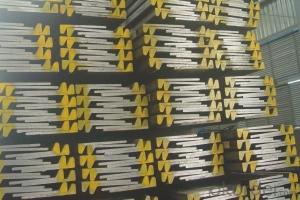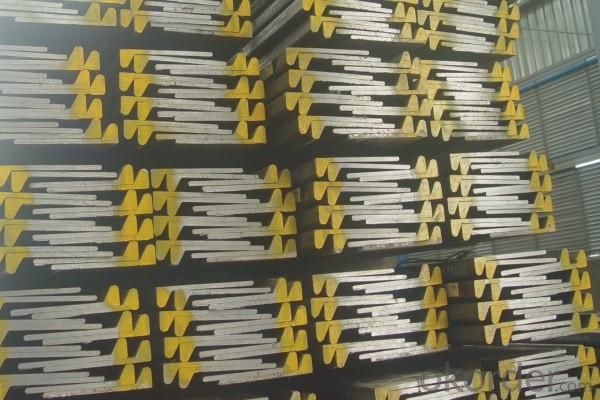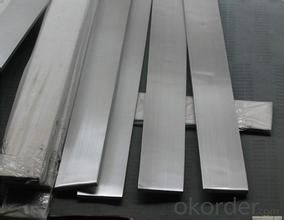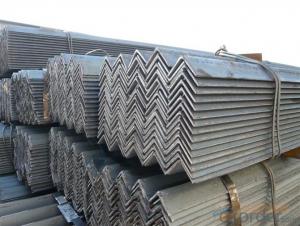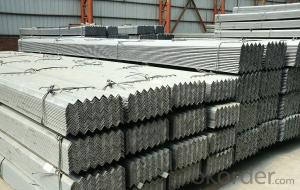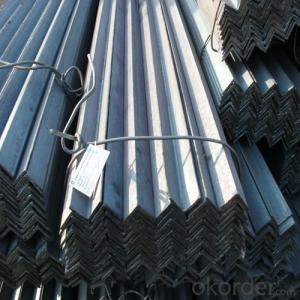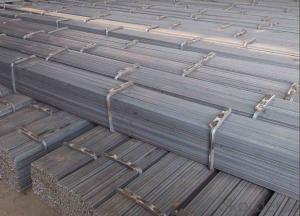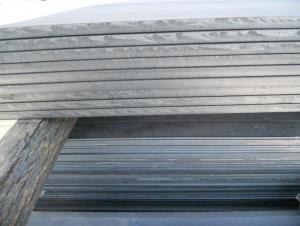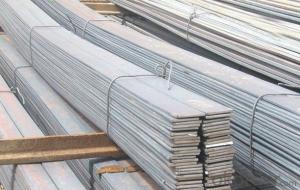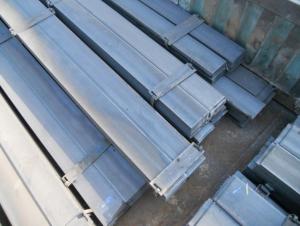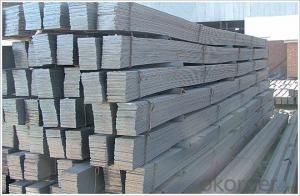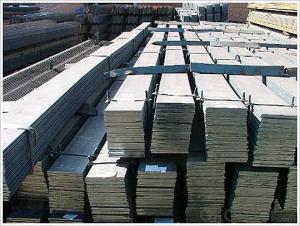Shipping Flat Bar Of Bulb Big size
- Loading Port:
- China Main Port
- Payment Terms:
- TT or LC
- Min Order Qty:
- -
- Supply Capability:
- -
OKorder Service Pledge
OKorder Financial Service
You Might Also Like
Product Description:
OKorder is offering Shipping Flat Bar Of Bulb Big size at great prices with worldwide shipping. Our supplier is a world-class manufacturer of steel, with our products utilized the world over. OKorder annually supplies products to European, North American and Asian markets. We provide quotations within 24 hours of receiving an inquiry and guarantee competitive prices.
Product Applications:
Shipping Flat Bar Of Bulb Big sizeare ideal for structural applications and are widely used in the construction of buildings and bridges, and the manufacturing, petrochemical, and transportation industries.
Product Advantages:
OKorder's Shipping Flat Bar Of Bulb Big size are durable, strong, and resist corrosion.
Main Product Features:
· Premium quality
· Prompt delivery & seaworthy packing (30 days after receiving deposit)
· Corrosion resistance
· Can be recycled and reused
· Mill test certification
· Professional Service
· Competitive pricing
Product Specifications:
Manufacture: Hot rolled
Grade: Q195 – 235
Certificates: ISO, SGS, BV, CIQ
Length: 6m – 12m, as per customer request
Packaging: Export packing, nude packing, bundled
Chinese Standard (H*W*T) | Weight (Kg/m) | 6m (pcs/ton) | Light I (H*W*T) | Weight (Kg/m) | 6m (pcs/ton) | Light II (H*W*T) | Weight (Kg/m) | 6M |
100*68*4.5 | 11.261 | 14.8 | 100*66*4.3 | 10.13 | 16.4 | 100*64*4 | 8.45 | 19.7 |
120*74*5.0 | 13.987 | 11.9 | 120*72*4.8 | 12.59 | 13.2 | 120*70*4.5 | 10.49 | 15.8 |
140*80*5.5 | 16.89 | 9.8 | 140*78*5.3 | 15.2 | 10.9 | 140*76*5 | 12.67 | 13.1 |
160*88*6 | 20.513 | 8.1 | 160*86*5.8 | 18.46 | 9 | 160*84*5.5 | 15.38 | 10.8 |
180*94*6.5 | 24.143 | 6.9 | 180*92*6.3 | 21.73 | 7.6 | 180*90*6 | 18.11 | 9.2 |
200*100*7 | 27.929 | 5.9 | 200*98*6.8 | 25.14 | 6.6 | 200*96*6.5 | 20.95 | 7.9 |
220*110*7.5 | 33.07 | 5 | 220*108*7.3 | 29.76 | 5.6 | 220*106*7 | 24.8 | 6.7 |
250*116*8 | 38.105 | 4.3 | 250*114*7.8 | 34.29 | 4.8 | 250*112*7.5 | 28.58 | 5.8 |
280*122*8.5 | 43.492 | 3.8 | 280*120*8.2 | 39.14 | 4.2 | 280*120*8 | 36.97 | 4.5 |
300*126*9 | 48.084 | 3.4 | 300*124*9.2 | 43.28 | 3.8 | 300*124*8.5 | 40.87 | 4 |
320*130*9.5 | 52.717 | 3.1 | 320*127*9.2 | 48.5 | 3.4 | |||
360*136*10 | 60.037 | 2.7 | 360*132*9.5 | 55.23 | 3 |
FAQ:
Q1: Why buy Materials & Equipment from OKorder.com?
A1: All products offered byOKorder.com are carefully selected from China's most reliable manufacturing enterprises. Through its ISO certifications, OKorder.com adheres to the highest standards and a commitment to supply chain safety and customer satisfaction.
Q2: How do we guarantee the quality of our products?
A2: We have established an advanced quality management system which conducts strict quality tests at every step, from raw materials to the final product. At the same time, we provide extensive follow-up service assurances as required.
Q3: How soon can we receive the product after purchase?
A3: Within three days of placing an order, we will begin production. The specific shipping date is dependent upon international and government factors, but is typically 7 to 10 workdays.
Q4: What makes stainless steel stainless?
A4: Stainless steel must contain at least 10.5 % chromium. It is this element that reacts with the oxygen in the air to form a complex chrome-oxide surface layer that is invisible but strong enough to prevent further oxygen from "staining" (rusting) the surface. Higher levels of chromium and the addition of other alloying elements such as nickel and molybdenum enhance this surface layer and improve the corrosion resistance of the stainless material.
Q5: Can stainless steel rust?
A5: Stainless does not "rust" as you think of regular steel rusting with a red oxide on the surface that flakes off. If you see red rust it is probably due to some iron particles that have contaminated the surface of the stainless steel and it is these iron particles that are rusting. Look at the source of the rusting and see if you can remove it from the surface.
Images:
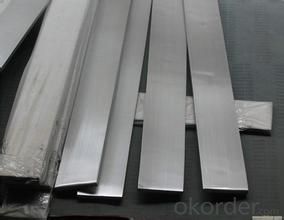
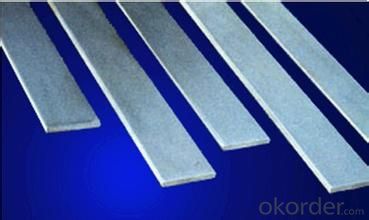
- Q: What is the difference between galvanized steel bar and ordinary angle iron?
- Low handling costs: the cost of hot dip galvanizing is lower than that of other paint coatings;
- Q: Can steel angles be used for decorative purposes?
- Yes, steel angles can definitely be used for decorative purposes. They can be shaped and designed in various ways to add a modern and industrial touch to interior or exterior spaces. Steel angles can be used as decorative accents, such as in furniture design, architectural details, or even as standalone decorative pieces. Their durability and versatility make them an excellent choice for adding a unique and stylish element to any space.
- Q: What are the common surface treatments for steel angles?
- The common surface treatments for steel angles include galvanizing, painting, and powder coating.
- Q: How do steel angles contribute to the sustainability of a project?
- There are several ways in which steel angles contribute to the sustainability of a project. Firstly, they are typically made from recycled steel, which reduces the need for new materials and helps conserve natural resources. This also minimizes the project's environmental impact. Additionally, steel is one of the most recycled materials worldwide, so at the end of the project's life cycle, the steel angles can be recycled again, further reducing waste and the project's carbon footprint. Secondly, steel angles are known for their durability and long-lasting nature. They have high strength-to-weight ratios, allowing for efficient and cost-effective designs. This durability ensures that the project will have a long lifespan, reducing the need for frequent repairs or replacements. By avoiding premature replacements, the project can minimize waste and its associated environmental impact. Furthermore, steel angles are highly versatile and can be used in a wide range of applications. This versatility allows for efficient use of materials and the ability to adapt to changing needs or requirements. For instance, steel angles can be used to create structural frames or support systems, which can help optimize the use of natural light and reduce the need for artificial lighting or heating. This, in turn, contributes to the overall energy efficiency of the project. Lastly, steel angles are highly resistant to corrosion and weathering. This resistance ensures that the project's structural integrity is maintained over time, reducing the need for maintenance and repair activities. This not only saves costs but also minimizes the use of resources and energy associated with maintenance activities. In conclusion, steel angles are an eco-friendly choice for projects due to their recycled materials, durability, versatility, and resistance to corrosion. By incorporating steel angles, wastage can be reduced, natural resources can be conserved, energy efficiency can be optimized, and the overall environmental impact can be minimized.
- Q: Can steel angles be used as bracing elements?
- Indeed, steel angles have the capability to serve as bracing elements. Construction and engineering projects frequently employ steel angles due to their robustness and longevity. These angles are commonly utilized to furnish structural support and stability, including as bracing elements. A rigid and secure bracing system can be established by either bolting or welding steel angles to other structural components. The design of these angles, with their L-shape, facilitates easy attachment to other members, thus imparting additional strength and resilience against lateral forces like wind or seismic loads. In summary, steel angles are a dependable choice for bracing elements across a wide range of applications, encompassing buildings, bridges, and industrial structures.
- Q: How do steel angles contribute to the overall stability of a building frame?
- Steel angles contribute to the overall stability of a building frame by providing structural support and reinforcement. They are commonly used as braces and connections in building frames to increase their load-bearing capacity and resist forces such as wind, earthquakes, and heavy loads. The angles help distribute and transfer the loads throughout the structure, enhancing its stability and preventing deformation or collapse.
- Q: What are the different types of steel angles used in bridges?
- A variety of steel angles are commonly utilized in bridge construction for different purposes. These include: 1. Equal Leg Angles: These angles possess equal legs and are frequently employed to provide structural support in bridge construction. They contribute stability and strength to the bridge structure. 2. Unequal Leg Angles: These angles have uneven legs and are used when additional strength or specific load-bearing requirements are necessary. They are often combined with equal leg angles to evenly distribute weight and provide support. 3. L-Shaped Angles: L-shaped angles serve various purposes in bridge construction, such as connecting beams and columns or offering additional support at connection points. They are often used in conjunction with other angle types to create a robust and well-supported bridge structure. 4. Tapered Angles: Tapered angles find application in bridges where a change in width or height is required. They are frequently utilized in bridge piers or abutments to ensure a seamless transition between different sections of the bridge. 5. Bent Angles: Bent angles are used in bridges that require a specific angle to accommodate the design or alignment of the bridge. These angles are often custom-made to suit the specific needs of the bridge construction project. 6. Hollow Structural Section (HSS) Angles: HSS angles are hollow steel sections employed in bridge construction to enhance strength and reduce the overall weight of the structure. They are commonly utilized in situations where weight reduction is a priority, such as in long-span bridges or bridges with high load-bearing requirements. Each of these steel angles serves a distinct purpose in bridge construction, and their selection depends on factors such as design requirements, load-bearing capacity, and structural stability necessary for the bridge.
- Q: What is the keel of the aluminum single board suspended or the welded frame of angle steel?
- The marking order of light steel keel is: product name, code name, width of section shape, height, steel plate thickness and standard number. Such as cross section shape is "C" type, width of 50mm, height of 15mm, steel plate thickness of 1.5mm ceiling keel marked: construction light steel keel.
- Q: What are the fire resistance properties of steel angles?
- Steel angles, known as L-shaped metal bars, possess exceptional fire resistance properties. Their high melting point and inability to easily combust or support the spread of fire are due to the composition and structure of steel. In the event of a fire, steel angles maintain their structural integrity for an extended period, allowing occupants to evacuate and firefighters to control the situation. This fire resistance is attributed to steel's non-combustible nature and efficient heat dissipation. Furthermore, steel angles have low thermal conductivity, which prevents the rapid spread of fire and reduces the risk of structural failure. Consequently, fire-resistant building designs and constructions often incorporate steel angles as a reliable and safe option for structural support in fire-prone environments.
- Q: How are steel angles inspected for quality and compliance with standards?
- Steel angles are inspected for quality and compliance with standards through a series of rigorous tests and inspections. These inspections are carried out by qualified personnel, often trained and certified in non-destructive testing (NDT) methods. The inspection process begins with a visual examination of the steel angles, looking for any surface defects such as cracks, pits, or sharp edges. This examination ensures that the angles are free from any visible defects that may compromise their strength and structural integrity. Next, dimensional checks are performed to verify that the steel angles meet the specified dimensions and tolerances as outlined in the applicable standards. This includes measuring the length, width, thickness, and other critical dimensions to ensure they align with the required specifications. To evaluate the internal soundness of the steel angles, non-destructive testing methods are employed. These methods include ultrasound testing (UT), magnetic particle testing (MT), liquid penetrant testing (PT), and radiographic testing (RT). UT uses high-frequency sound waves to detect any internal flaws or discontinuities, while MT and PT involve the application of magnetic particles or liquid dyes to detect surface cracks or defects. RT, on the other hand, uses X-rays or gamma rays to inspect the internal structure of the steel angles. Mechanical tests are also conducted to assess the mechanical properties of the steel angles. These tests may include tensile testing, which measures the strength and elasticity of the material, and hardness testing, which determines the resistance of the steel to indentation or scratching. These tests ensure that the steel angles possess the required mechanical strength and properties as specified by the standards. Furthermore, chemical analysis is carried out to verify the chemical composition of the steel angles, particularly the levels of various alloying elements. This analysis ensures that the steel meets the required chemical composition standards, which directly influence its strength, corrosion resistance, and other properties. In addition to these inspections, steel angles may also undergo surface treatment testing, such as coating thickness measurement, adhesion testing, or salt spray testing, to ensure that any protective coatings or finishes applied meet the required standards. Overall, the inspection process for steel angles is comprehensive and involves a combination of visual examinations, dimensional checks, non-destructive testing, mechanical tests, chemical analysis, and surface treatment testing. These inspections are crucial to ensure that the steel angles meet the necessary quality and compliance standards, providing confidence in their performance and reliability in various applications.
Send your message to us
Shipping Flat Bar Of Bulb Big size
- Loading Port:
- China Main Port
- Payment Terms:
- TT or LC
- Min Order Qty:
- -
- Supply Capability:
- -
OKorder Service Pledge
OKorder Financial Service
Similar products
Hot products
Hot Searches
Related keywords
